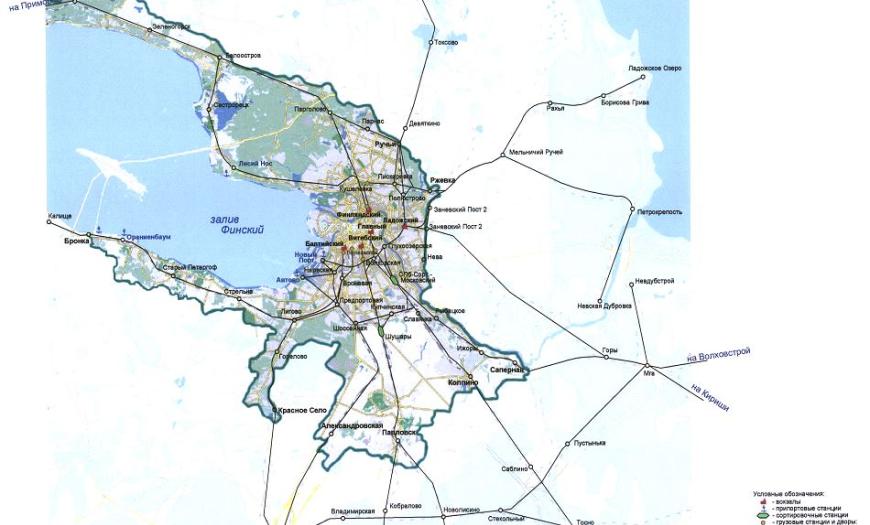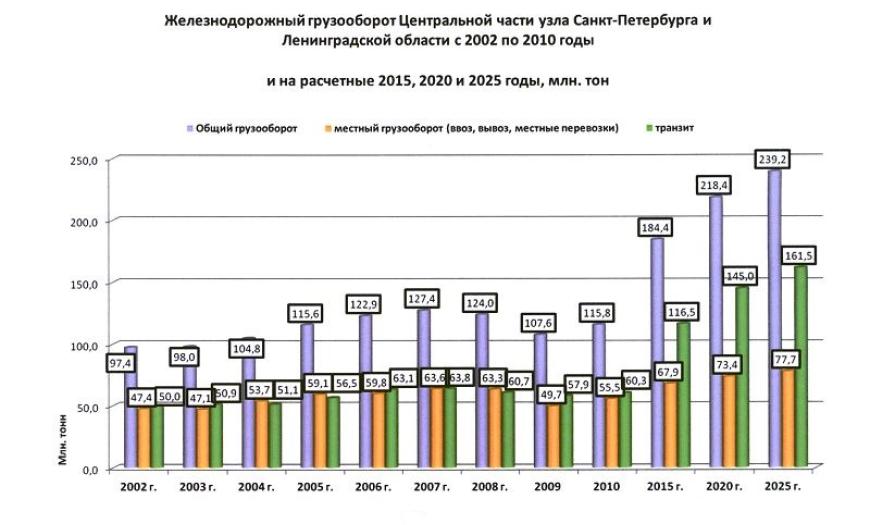In the 2010s, Lengiprotrans developed a program for the development of railway infrastructure until 2025 in St. Petersburg and the Leningrad Region to ensure the prospective growth of passenger and freight traffic, subject to their quality improvement and consolidation with the development of other types of transport. To implement the program, research work “Scientifically grounded proposals for the effective development of the transport and technological infrastructure of the railway junction of St. Petersburg and the Leningrad region to ensure promising freight and passenger traffic” was carried out.
As a result of the analysis, the specifics of the prospects for the growth of freight traffic in the node were revealed, which consists in:
- A significant increase in the volume of cargo transshipment between rail and sea transport in the seaports of the Gulf of Finland located on the territory of the Leningrad Region. In particular, in connection with the displacement of a part of the export transshipment from foreign ports to the ports of Russia.
- Needs of removal from the central historical part of St. Petersburg cargo yards of the stations St. Petersburg-Tovarny-Vitebsky, St. Petersburg-Baltiysky, St. Petersburg-Finlyandsky.
- The need to develop railway sections in order to pass the increasing transit traffic and direct it around the city.
- Overcoming the tendency of dispersal of the processing of inert construction materials among numerous intra-hub stations and their location outside the settlements.
Taking into account this specificity, the possible ways that contribute to the development of railway infrastructure are highlighted:
- Integrated development of the port Ust-Luga railway junction.
- Partial reconstruction of Novy Port and Avtovo stations serving the I, II, III and IV regions of the Big Port of St. Petersburg.
- Reconstruction of Oranienbaum and Bronka stations.
- Strengthening of railway approaches to the port of Primorsk on the Vyborg - Ermilovo section.
- Completion of the reconstruction of the Mga - Gatchina - Weimarn - Luzhskaya railway line in order to provide approaches to the port of Ust-Luga, as well as the completion of the construction of the Losevo - Kamennogorsk railway line and the reconstruction of the Kamennogorsk - Vyborg section with the aim of passing freight trains to the ports of Finland in the north of the Gulf of Finland ...
- Development of border railway crossings Ivangorod and Svetogorsk.
- Construction of the north-eastern railway bypass of St. Petersburg according to one of the options: Myaglovo - Toksovo or Manushkino - Toksovo.
- Construction of additional main tracks on the Novolisino - Pavlovsk and Pavlovsk - Detskoe Selo - Shushary sections.
- Construction of cargo areas for processing local cargo in the vicinity of Parnas station or near Kapitolovo station, as well as at Shushary station, subject to its comprehensive reconstruction.
- Placement of railway terminals for unloading inert construction materials for the needs of the construction complex of the Petersburg urban agglomeration in the area of Verevo and Manushkino stations.







